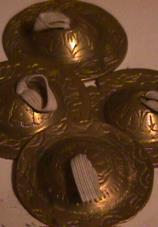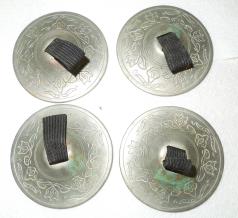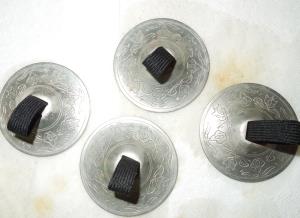Care of Zills
There are a variety of finger cymbals ranging from the cheap poor quality ones to the expensive professional quality ones. Prices can range from $2 - $70. Now, I suppose if you just have a cheap poor quality pair of cymbals preventative care and maintanence may not matter but if you have a decent quality pair and/or invested more money in them you will most likely want to keep them in good working condition for as long as possible. Especially since after working with the same pair for a long time it becomes familiar and comfortable so replacing your zills is sometimes like breaking in a new pair of shoes.
The first thing to do and best possible way to keep your finger cymbals is to prevent damage and oxidation. To do this it is best to store you finger cymbals in a bag. Many people like to use a simple drawstring pouch or a small formal wear purse. Drawsting pouches are easy to sew or can be purchased at many street art fairs, renaissance festivals, and of course on-line. Many zills even come with their own drawstring bag (often not the best quality of bag so you probably should keep the idea of finding a replacement not too far off in your mind). I also suggest having a soft cloth which you can layer between your zills and a soft cloth (like a shammy or other absorbent cloth) which you can use to wipe your zills dry before layering and storing in the bag. Preventative care is rather easy. After you use your zills take a dry cloth and dry them thouroughly. Next, lay down your other cloth and place one zill on a corner, fold the cloth over the top of the zill and place the next zill on top and fold the cloth back over the top of the second zill. Continue until the cloth has been layered between all four zills then tuck the excess around and place them in the bag. Drying them thouroughly keeps them clean and helps prevent tarnish and oxidation. While cleaning if you notice any tarnish starting or any oxidation occuring try buffing ith your cloth. In early stages this is usually enough to reverse the proccess and slow the need to move onto other methods of repair. While you may think the zills won't need to be dried keep in mind that when your dancing with them they do get exposed to sweat and may very well from time to time end up with other things like makeup, glitter, and if your not careful even things like hummous. So wiping them clean and dry even if you don't think they are dirty or moist is always the best idea. Layering the cloth between them when they are in the bag helps to keep them protected from scratches since they cannot rub against each other as much, helps further protect them from dirt and moisture and helps protect them from oxidizing. Placing them in a bag further helps protect them from oxidation and the emelments as well as to provide some protection against heat and cold weather changes. Make sure you don't leave zills outside or in your car for an extended time as heat and cold can change the sound of your instrument. The temperature inside a car can get very hot in the summer sun and can get very cold on a winter night.
Assuming you have been taking preventitive measures to care for your zills they should remain in good condition for a long time. However if you should ever find yourself with a pair of zills that have either been neglected or have despite all the prevention methods managed to succumb to tarnish and oxidation the good news is most of it is reversible. Now, depending on the extent of the damage they may never look quite as good as they did when they were new but most can come pretty close or at least look decent. Start by first siply cleaning the zills. You want to remove any dirt, grime, oils, etc... before attempting to remove the tarnish and oxidation. Use a mild detergent like dish soap (no mosturizing ones though) and a soft cloth and scrub them clean. If all of the tarnish and oxidation is gone just buff them and dry them with a clean dry cloth. If they are not clean then you will have to resort to other methods. An easy method that works for most zills is to use a household acid such as lemon juice, lime juice, ketchup or worchestershire sauce (those last two may sound weird but they are acids and do work). I generally use lemon juice so that's what I'll refer to. you can try soaking the zills in the lemon juice for about 3 minutes or you can take a cloth wet it with lemon juice and then dip it in some salt and scrub the zills (for really bad cases you might want to try doing both). The salt acts as a slight abrasive to scratch away the oxidation and tarnish. In some cases the acid can react with the metal (usually zinc or steel mixes or impurities in the metal) to create a pink-ish coloring. You can remove this with cleaners like brasso or by using a very fine grain sand paper and sanding gently then buffing the areas with a soft cloth afterwards.
 A pair of zills in use for about 15
A pair of zills in use for about 15 



 The same zills cleaned with lemon juice and
The same zills cleaned with lemon juice and
 years exposed to the heat and
years exposed to the heat and 



 salt. Notice they are a bit brighter and more
salt. Notice they are a bit brighter and more
 cold extremes and the damp
cold extremes and the damp 



 shiny and most of the oxidation discoloration
shiny and most of the oxidation discoloration
 weather of Minnesota and
weather of Minnesota and 




 is gone. A few of the brown spots are all that
is gone. A few of the brown spots are all that
 imporperly cared for. Notice the
imporperly cared for. Notice the



 remain.
remain.
 green and brown oxidation.
green and brown oxidation.
Besides cosmetic wear and tear over time the tone and pitch of your zills can also change and become a somewhat deadened tone. When this happens if the sound quality bothers you the only choices are to either buy a new pair or attemt to cure them. If you attempt to cure the zills you should keep in mind that while the sound will change it may not be a better sound and it most likely will not be the same original sound that the zills once had. To cure them, remove any elastic, ribbon, or cord and place them on a baking tray. Pre-heat the oven to 350 degrees Farenheight. Once heated put the tray with the zills in the oven and bake them for 15 minutes. Make sure to let them fully cool before touching them as they will be vey hot. Since the results of this process may or may not be desirable I'd recommend using this as a last course of action so that if you end up hating them it won't be too devastating to just throw them away.
The only other maintainence that you need to worry about is the elastic which should be replaced ocasisonally. It's best to use non-roll elastic. For the two-slot cymbals simply place one end of the elasatic downward through the top creating a loop on the top for your finger. Make sure it will fit snugly and then you can fasten it with a small safety pin or you can sew the elastic. Some prefer pinning because it's easy to readjust as needed while others prefer sewing because ot is more secure. Personally I'm a fan of sewing it as I prefer the stability and knowing that the elastic is secure. How often you use your zills will determine how often you'll need to replace the elastic. It will naturally lose some of it's elasticity over time and become somewhat hard and loose. You can keep adjusting it as long as some of the elsaticity is left or your can replace the elastic completely. If you use them quite frequently you may find yourself changing elastic every 6 months to a year if you use them moderately you could go maybe 3 years. Some dancers like to use one color elastic on the zills that go on their thumbs and another for the zills that go on their middle fingers to make it easier to know which ones go where for quickly putting them on.
If you would like to learn more about zills and other kinds of finger cymbals be sure to visit our About Zills page. If your looking to learn to play zills or want to learn new patterns visit our Zill Patterns page.




